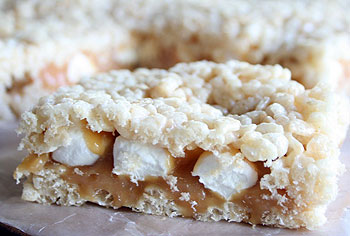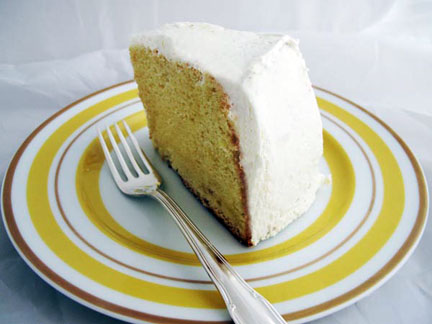 Surprised? I know. I wouldn’t normally post a recipe for sweet bars made with crisp rice cereal and marshmallows. I’m going to a family reunion. There will be lots of kids there — little ones and big ones, too, if you know what I mean. Kids love rice krispie bars. I’m taking a very light, bright and healthful cabbage salad, too. So, it will all balance out in the sugar and calorie department.
Surprised? I know. I wouldn’t normally post a recipe for sweet bars made with crisp rice cereal and marshmallows. I’m going to a family reunion. There will be lots of kids there — little ones and big ones, too, if you know what I mean. Kids love rice krispie bars. I’m taking a very light, bright and healthful cabbage salad, too. So, it will all balance out in the sugar and calorie department.
This recipe came to me from a friend sometime in the early 1980′s. My boys were at a rice krispie bar stage of their lives. That stage coincided with a “not-much-time-to-bake” time in my life.
No-bake Caramel Krispies are made by making two layers of the rice krispie, butter and marshmallow mixture in jelly-roll pans. A filling of caramel, more butter and a can of sweetened condensed milk is heated together and when the caramels are melted, the mixture gets poured over one of the layers that has been sprinkled with more mini-marshmallows.

 Now that we’re in the peak of apple picking season, I realized that I never posted a basic apple pie recipe. Some people find making pies a daunting task. There are stories, mostly said in hushed tones, about my mother throwing more than a few pie crusts against the wall.
Now that we’re in the peak of apple picking season, I realized that I never posted a basic apple pie recipe. Some people find making pies a daunting task. There are stories, mostly said in hushed tones, about my mother throwing more than a few pie crusts against the wall. What is the all-time best dunking cookie? Italian biscotti. Whether it's a glass of sweet wine or a mug of steaming coffee, biscotti's firm, crunchy texture stands up to dunking like no other cookie I know.
What is the all-time best dunking cookie? Italian biscotti. Whether it's a glass of sweet wine or a mug of steaming coffee, biscotti's firm, crunchy texture stands up to dunking like no other cookie I know. As a kid, I always wondered why we never celebrated Halloween. Only as an adult did I come to realize that it's really just an American holiday. So, I thought to myself, when do Hungarian kids get a chance to dress up and be whomever they wish to be for one day? The answer is Carnival. I never got dressed up for the holiday, but in Hungary my little nephews always did for school. But never mind all those Mardi Gras celebrations, for me, the best part about Carnival are the doughnuts. Crispy, fluffy, and airy doughnuts!
As a kid, I always wondered why we never celebrated Halloween. Only as an adult did I come to realize that it's really just an American holiday. So, I thought to myself, when do Hungarian kids get a chance to dress up and be whomever they wish to be for one day? The answer is Carnival. I never got dressed up for the holiday, but in Hungary my little nephews always did for school. But never mind all those Mardi Gras celebrations, for me, the best part about Carnival are the doughnuts. Crispy, fluffy, and airy doughnuts! Chiffon cakes are airy, moist, and delicious. They have an interesting history too. Harry Baker, a Los Angeles insurance agent turned caterer, is credited with the original chiffon cake in 1927.
Chiffon cakes are airy, moist, and delicious. They have an interesting history too. Harry Baker, a Los Angeles insurance agent turned caterer, is credited with the original chiffon cake in 1927.
